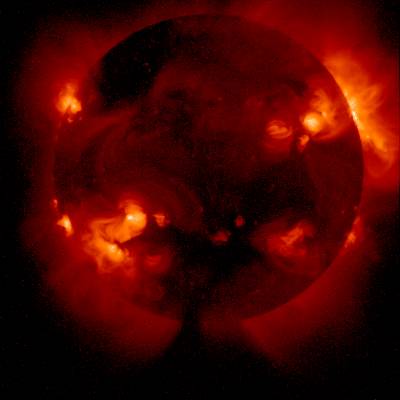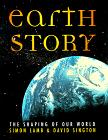Upanishads - the secret wisdom
A history of pantheism and scientific pantheism by Paul Harrison.
Are you a pantheist? Find out now at the Scientific Pantheism site. 

X-ray image of the sun
Thou art the dark-blue bird and the green parrot with red eyes,
Thou hast the lightning as thy child.
Thou art the seasons and the seas. [Svetasvatara 4.2.4]
The Upanishads are a collection of Indian speculations on the nature of reality and the soul and the relations between these two.
The texts date from around 600 BC. They often give the impression of a building under construction - an ongoing exploration of themes not yet fully resolved. No strictly coherent scheme can be extracted from the upanishads - not even from each single upanishad. Like the Bhagavad Gita they are the work of several hands.
If one theme unites these writings, it is the search for an underlying unity linking everything we see and think. That unity is called Brahman. In most texts, Brahman is said to be identical with Atman, the world soul, which is also identical with the atman of each individual. In this sense every individual is united with the cosmos, and only needs to realize this fact to reach fulfillment.
The upanishads are, thus, essentially pantheistic. However, their quest for unity went at times too far. Since the world we see is clearly highly diverse, some texts deduce that if the cosmos is unitary, then appearances must be delusory. They are maya - like a magical trick. The self, the presence of the cosmic Self within each person, is the `Real' world - a world of pure thought, which cannot be apprehended by the senses. Meanwhile the real sensible world of life and love, birth and death, is dismissed as no more than a dream projected by the self. Once a person realizes this, the illusion falls away and they become one with the All.
This view - similar in essence to most schools of Buddhism - contrasts strongly with realistic pantheisms which accept the material world as real. Idealistic pantheism fails to explain why we all dream the same dream - why the detail of the sensible world is shared by everyone present. It cannot explain why we should start to `dream' the world at all, nor why there should be a `we' to dream.
The belief that reality is illusion is perhaps the greatest illusion of all. It leads to indifference, inaction, insensitivity, world-blindness, death in life. Indeed in the upanishads all these are praised as the highest wisdom.
No life can be led in an illusory world - even hermits and monks have to eat, excrete, and sleep. Thus they are forced to acknowledge in action the reality of the world they deny in theory, and their own lives disprove their beliefs. The only life that is consistent with full acceptance of idealist pantheism is a hunger strike until death. The sage who wishes to survive another day must forget his wisdom.The extracts are from Robert Hume, The Thirteen Principal Upanishads, Oxford University Press, 1931.
Selected fragments.

Brahman is the whole world.
Thou art the dark-blue bird and the green parrot with red eyes,
Thou hast the lightning as thy child. Thou art the seasons and the seas.
Having no beginning, thou dost abide with all-pervadingness,
Wherefrom all beings are born. [Svetasvatara 4.2.4]Verily, this whole world in Brahman. Tranquil, let one worship it as that from which he came forth, as that into which he will be dissolved, as that in which he breathes. [Chandogya 3.14.1]
Brahman, indeed, is this immortal. Brahman before, Brahman behind, to right and left. Stretched forth below and above, Brahman, indeed, is this whole world. [Mundaka 2.2.11]
Atman, the world-soul, is the whole world.
Fire is His head; His eyes, the moon and sun; the regions of space, His ears; His voice, the revealed Vedas; Wind, His breath; His heart, the whole world. Out of His feet, the earth. Truly He is the Inner Soul of all. [Mundaka 2.2.4]
As all the spokes are held together in the hub of a wheel, just so in this Soul all things, all gods, all worlds, all breathing things, all selves are held together. [Brihadaranyaka 2.5.15]
Atman and Brahman are identical.
The Soul (Atman) which pervades all things . . this is Brahman. [Svetasvatara 1.16]
This Soul (Atman) is Brahman, made of knowledge, of mind, of breath, of seeing, of hearing, of earth, of water, of wind, of space, of energy and of non-energy, of desire and of non-desire, of anger and of non-anger, of virtue and of non-virtue. It is made of everything. [Brihadaranyaka 4.4.5]
The individual soul is indentical with Brahman/Atman.
The light which shines higher than this heaven . . verily, that is the same as the light which is here within a person. [Chandogya 3.13.7]
He who is in the fire, and he who is here in the heart, and he who is yonder in the sun - he is one. [Maitri 6.17]
He who breathes in with your breathing is the Soul of yours which is in all things. [Brihadaranyaka 3.4.1]
He who consists of mind, whose body is life-breath, whose form is light, whose conception is truth, whose soul is space, containing all works, containing all desires, containing all odors, containing all tastes, encompassing this whole world … this Soul of mine within the heart is smaller than a grain of rice, or a barley-corn, or a mustard-seed, or a grain of millet, or the kernel of a grain of millet. This Soul of mine is greater than the earth, greater than the atmosphere, greater than the sky, greater than these worlds. [Chandogya 3.14.2-3]
As far, verily, as this world-space extends, so far extends the space within the heart. Within it are contained both heaven and earth, both fire and wind, both sun and moon, lightning and the stars, both what one possesses here and what one does not possess; everything here is contained within it… That is the Soul, free from evil, free from age, free from death, free from sorrow, free from hunger, free from thirst, whose desire is the Real, whose conception is the Real. [Chandogya 8.1.3-4]
The diversity of appearances is an illusion.
There is on earth no diversity.
He gets death after death
Who perceives here seeming diversity.
As a unity only is It to be looked upon -
this indemonstrable, enduring Being.
[Brihadaranyaka 4.4.19-20]This whole world the illusion maker projects out of this [Brahman].
And in it by illusion the other is confined.
Now, one should know that Nature is illusion,
And that the Mighty Lord is the illusion maker.
[Svetasvatara 4.9-10]There are no chariots there, no bridges, no roads. But he projects from himself chariots, bridges, roads. There are no blisses there, no pleasures, no delights. But he projects from himself blisses, pleasures, delights. There are no tanks there, no lotus-pools, no streams. But he projects from himself tanks, lotus-pools, streams. For he is a creator… In the state of sleep, going high and low, a god, he makes many forms for himself. [Brihadaranyaka 4.3.10-12]
The true Brahman is beyond understanding by words or concepts.
Neti, neti - not this, not this. [Brihadaranyaka 2.3.6]
It is not coarse, not fine, not short, not long, . . without shadow, without darkness, without air and without space, intangible, odorless, tasteless, without eye, without ear, without voice, without mind, without energy, without breath, without mouth . . unaging, undying, without fear, immortal, without stain, without measure, without inside and without inside. [Brihadaranyaka 3.8.8]
It is to be known through thought - not senses.
Not by sight is It grasped, not even by speech,
Not by any other sense-organs, austerity, or work . .
That subtile Soul is to be known by thought.
[Mundaka 3.1.8-9]
Knowledge and inaction are better than action.
Having scrutinized the worlds that are built up by work, a Brahman should arrive at indifference. The world that was not made is not won by what is done. [Mundaka 1.12].
Knowledge of self brings knowledge of cosmos.
One should reverence the thought `I am the world-all.' [Chandogya 7.25.1]
Verily, with the seeing of, with the hearing of, with the thinking of, and with the understanding of the soul, this world-all is known [Brihadaranyaka 2.4.5]
That art thou. [Chandogya 6.8-16]
Knowing the unity of self and world is liberation
Whoever thus knows `I am Brahman!' becomes this all; even the gods have no power to prevent him becoming thus, for he becomes their self. [Brihadaranyaka 1.4.10]
`He, knowing all, becomes the All. [Prasna 4.10]
This unity is beyond dualism and beyond normal cognition.
Where there is a duality, as it were, there one sees another; there one smells another; there one tastes another; there one speaks to another… But where everything has become just one's own self, then whereby and whom would one see? Then whereby and whom would one smell? then whereby and whom would one speak? then whereby and whom would one hear? then whereby and whom would one think? then whereby and whom would one touch? then whereby and whom would one understand? [Brihadaranyaka 2.4.14]
As a man, when in the embrace of his beloved wife, knows nothing within or without, so this person when in the embrace of the intelligent Soul knows nothing within or without. [Brihadaranyaka 4.3.21]
Death is the ultimate union of self and All.
When a person is dying, his voice goes into his mind; his mind into his breath; his breath into heat; the heat into the highest divinity. that which is the finest essence - the whole world has that as its soul. That is Reality. That is Atman. That art thou, Svetaketu. [Chanodgya 6.8.6]
As these flowing rivers that tend towards the ocean, on reaching the ocean disappear, their name and form are destroyed and it is called simply "the ocean" - even so of this spectator these sixteen parts that tend towards the Person [Purusha, the cosmic unity], on reaching the Person disappear, their name and form are destroyed, and it is called simply "the Person." [Prasna 6.5]
Death is better than life.
When one has come into the presence of undecaying immortals,
What decaying mortal here below, who understands,
who meditates on the pleasures of beauty and delight,
Would delight in a life over-long? [Katha 1.28]When are cut all the knots of the heart here on earth, then a mortal becomes immortal! [Katha 6.15]
Background image: solar disc in randomized false colours to symbolize that in the Upanishads, sensible reality is considered to be the veil of true `Reality' which is formless.
SCIENTIFIC PANTHEISM
is the belief that the universe and nature are divine.
It fuses religion and science, and concern for humans with concern for nature.
It provides the most realistic concept of life after death,
and the most solid basis for environmental ethics.
It is a religion that requires no faith other than common sense,
no revelation other than open eyes and a mind open to evidence,
no guru other than your own self.
 Elements of Pantheism,
An overview of pantheist history, theory and practice. Includes almanac and
calendar. |
 
 The Finest of Religion, Science,
Nature and Philosophy Bookstore |
Suggestions, comments, criticisms to: Paul Harrison, e-mail: pan(at)(this domain)
© Paul Harrison 1996. Last update March 10, 1997.

